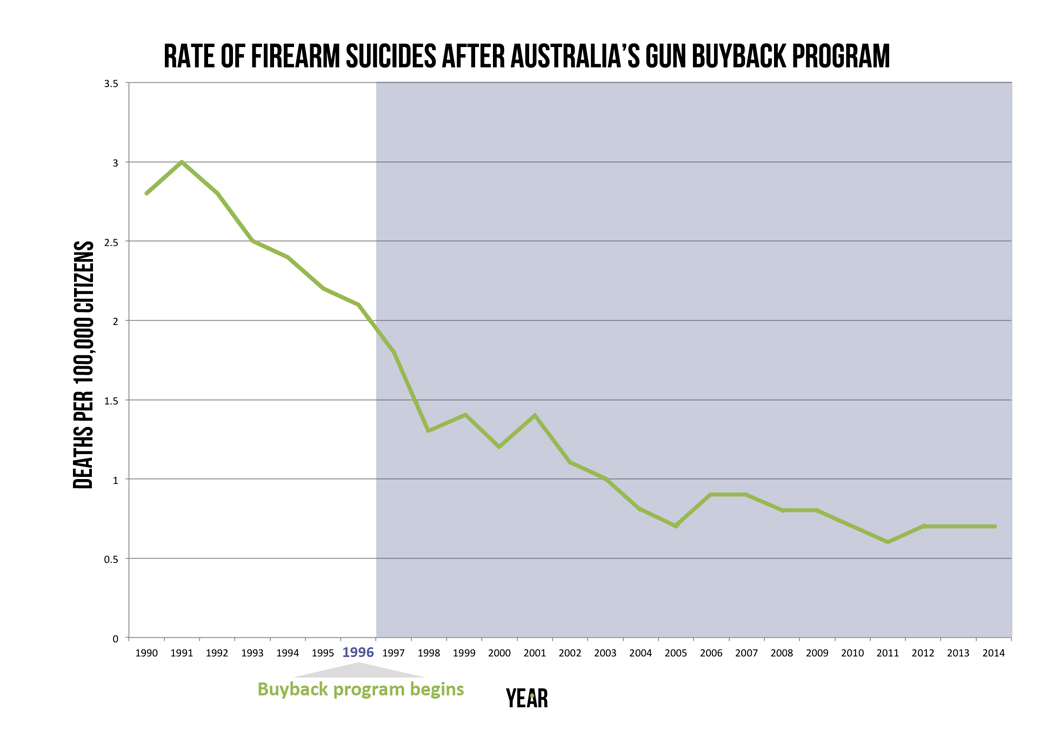Mass shootings in America often get the most attention in debates on gun control. But there’s another big issue we don’t talk about enough: suicide.
Data shows that suicide rates have reached an all-time high in the past three decades. There are 20,000 gun-related suicides in the United States every year, which accounts for more than half of all suicides. The widespread availability of firearms only hurts this issue. While suicide is complex, limiting the number of and access to firearms can help to reduce and prevent thousands of deaths by suicide each year.
Taking one’s own life is the second most common cause of death among Americans between ages 15 and 34 and the 10th most common cause of death at any age. While all suicides aren’t gun related, a majority are. Drug overdose, the most commonly used method for suicide, results in death only 3 percent of the time, while 85 percent of gun suicides are successful, indicating that guns could be the most lethal weapon for committing suicide.
Most people who make the final decision to end their lives attempt suicide shortly after. When you have a gun readily available, the decision is swifter and more reliable than those who wait or plan. Tactics like gun licensing laws, background checks and gun-suicide awareness campaigns can help slow down the process and save lives.
To enact this in the United States, we should look at how increased regulations played out around the world. Israel is a proven example of how gun control can reduce suicides. Because of the high suicide rates among military members, the army stopped allowing soldiers to take their service weapons home with them on weekends and the suicide rate fell by 40 percent in 2006.
In Australia, after a national gun buyback in 1996 that bought around 650,000 guns back from Australians — almost 20 percent of the guns owned in the country — the rate at which people died by suicide with guns decreased by 80 percent.

In the United States, the top three states with the highest number of guns — Wyoming, Montana and Alaska — are among the four top states with the highest rates of suicide.
Studies published in 2013 found that among all age groups, states with higher rates of gun ownership per household also had higher rates of firearm suicides. And youth with access to guns at home are also often the victims of disturbing suicides. Take the example of a 15-year-old girl from Arizona who shot and killed her girlfriend and another friend before taking her own life. A classmate reportedly gave her the gun, after she asked for one for protection and he took a gun from his house to let her borrow.
Even when Americans lawfully and responsibly own guns, there’s no way to guarantee they will always be secure and used only for self-protection or recreation.
But suicide rates fall when states require licensing. Connecticut’s suicide-by-firearm rate fell by 15.4 percent after permits were required to purchase handguns in 1995 and, conversely, when Missouri repealed their gun licensing law in 2007, suicide rates increased.
When it comes down to timing, even brief delays in accessing firearms can help. A report from Harvard’s School of Public Health conducted in 2001 focused on 13- to 34-year-olds who attempted suicide but were saved by medical intervention. For more than two-thirds of these people, the time that elapsed between deciding to act and taking action was an hour or less.
While there are other factors we must consider when discussing suicide rates — namely mental health awareness and treatment or economic and geographic factors — restricting gun access and availability is a necessary step to take in order to start combating our high rates of suicide.
To reduce these fatalities, blocking access to hard-to-fail methods like guns can curb and prevent suicides. Chances of fatality rise drastically when guns are present because guns kill easily, quickly and offer little to no time for reconsideration.
Even without access to firearms, suicides would still occur by other methods. But methods that are not gun related take more time and planning. Limiting people’s access to guns means increasing the time one would have to rethink their decision or be stopped by someone intervening. Even if gun control only saves a fraction of these victims’ lives, it is well worth it.
State licensing laws and mandatory background checks for gun ownership can slow access to guns. Even a short delay can be effective in preventing suicides as it would cause someone to contemplate their decision as they wait to get their gun.
While the debate on gun control continues, the simplest way to start making this change is for gun owners to lock up their firearms in safes and store the ammunition somewhere separate. No mental health campaign or gun control policy is going to completely prevent every suicide. But right now, the small steps we can and should take include encouraging heavier gun control laws.
If we want to reduce suicides, we can start with reducing the weapons available for committing them.
Erica primarily writes about social issues and mental health for The Pitt News.
Write to Erica at [email protected].
If you or a friend are struggling with depression, anxiety, suicidal thoughts or any form of mental illness:
Call the Counseling Center at 412-648-7930, 8:30 A.M. to 5 P.M. or 1-888-796-8226 any time, for any reason.
If you need immediate help or counseling, call the Pitt Police at 412-624-2121.
To participate in a group counseling session any day of the week, call or visit the counseling center on the second floor of Nordenberg Hall between 8:30 A.M. and 5 P.M.
Off campus options:
Western Psychiatric Institute and Clinic: 412-624-1000
Re:Solve Crisis Network: 1-888-796-8226



